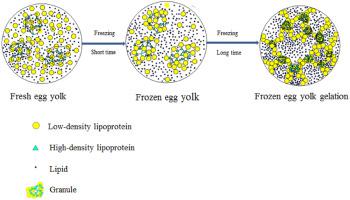当前位置:
X-MOL 学术
›
Food Hydrocoll.
›
论文详情
Our official English website, www.x-mol.net, welcomes your
feedback! (Note: you will need to create a separate account there.)
Changes in gelation, aggregation and intermolecular forces in frozen-thawed egg yolks during freezing
Food Hydrocolloids ( IF 11.0 ) Pub Date : 2020-11-01 , DOI: 10.1016/j.foodhyd.2020.105947 Ruihong Wang , Yanqiu Ma , Zihong Ma , Qingpu Du , Ying Zhao , Yujie Chi
Food Hydrocolloids ( IF 11.0 ) Pub Date : 2020-11-01 , DOI: 10.1016/j.foodhyd.2020.105947 Ruihong Wang , Yanqiu Ma , Zihong Ma , Qingpu Du , Ying Zhao , Yujie Chi

|
Abstract The changes in gelation, aggregation and intermolecular forces in frozen-thawed egg yolks during freezing were determined to clarify the mechanism of frozen-induced egg yolk gel formation. The results indicated that the frozen-thawed egg yolks lost their fluidity after 6 h of freezing, as shown in the graph. Back extrusion rheology showed that the yolk viscosity and consistency increased significantly when the egg yolk was frozen for the designated amount of time (1, 2, 3, 4, 5, and 6 h). The gel strength, hardness and adhesiveness of egg yolks frozen for 7–12 h tended to increase. Turbidity analysis results indicated that the turbidity of frozen-thawed egg yolks significantly increased, but SDS-PAGE results showed that the protein patterns of the frozen-thawed egg yolks did not change during freezing. Upon gelation of the frozen-thawed yolks, the free sulfhydryl content in the frozen-thawed egg yolks decreased significantly, and the content of disulfide bonds initially increased and then slightly decreased. There was no significant difference between the surface sulfhydryl content and the surface hydrophobicity of the frozen-thawed egg yolks, but both were higher than those of fresh egg yolks. The results of the analysis of intermolecular forces demonstrated that hydrophobic interactions, hydrogen bonding, and interactions between hydrophobic groups and disulfide bonds could stabilize the protein gel network. Raman spectroscopy further revealed that the secondary structures of egg yolk proteins changed. These results suggested that the characteristic gel of frozen-thawed egg yolks was formed as a result of multiple interactions among protein molecules.
中文翻译:

冷冻过程中冻融蛋黄凝胶化、聚集和分子间力的变化
摘要 测定冷冻过程中冻融蛋黄凝胶化、聚集和分子间作用力的变化,以阐明冷冻诱导蛋黄凝胶形成的机制。结果表明,冻融的蛋黄在冷冻 6 小时后失去了流动性,如图所示。反挤压流变学表明,当蛋黄冷冻指定的时间(1、2、3、4、5 和 6 小时)时,蛋黄的粘度和稠度显着增加。冷冻 7-12 小时的蛋黄的凝胶强度、硬度和粘附性有增加的趋势。浊度分析结果表明冻融蛋黄的浊度显着增加,但SDS-PAGE结果显示冻融蛋黄的蛋白质模式在冷冻过程中没有变化。冻融蛋黄凝胶化后,冻融蛋黄中游离巯基含量显着降低,二硫键含量先升高后略降低。冻融蛋黄的表面巯基含量与表面疏水性无显着差异,但均高于新鲜蛋黄。分子间力的分析结果表明疏水相互作用、氢键以及疏水基团与二硫键之间的相互作用可以稳定蛋白质凝胶网络。拉曼光谱进一步揭示了蛋黄蛋白的二级结构发生了变化。
更新日期:2020-11-01
中文翻译:

冷冻过程中冻融蛋黄凝胶化、聚集和分子间力的变化
摘要 测定冷冻过程中冻融蛋黄凝胶化、聚集和分子间作用力的变化,以阐明冷冻诱导蛋黄凝胶形成的机制。结果表明,冻融的蛋黄在冷冻 6 小时后失去了流动性,如图所示。反挤压流变学表明,当蛋黄冷冻指定的时间(1、2、3、4、5 和 6 小时)时,蛋黄的粘度和稠度显着增加。冷冻 7-12 小时的蛋黄的凝胶强度、硬度和粘附性有增加的趋势。浊度分析结果表明冻融蛋黄的浊度显着增加,但SDS-PAGE结果显示冻融蛋黄的蛋白质模式在冷冻过程中没有变化。冻融蛋黄凝胶化后,冻融蛋黄中游离巯基含量显着降低,二硫键含量先升高后略降低。冻融蛋黄的表面巯基含量与表面疏水性无显着差异,但均高于新鲜蛋黄。分子间力的分析结果表明疏水相互作用、氢键以及疏水基团与二硫键之间的相互作用可以稳定蛋白质凝胶网络。拉曼光谱进一步揭示了蛋黄蛋白的二级结构发生了变化。































 京公网安备 11010802027423号
京公网安备 11010802027423号